with 🎙️ Scott Hamilton, Researcher, Policy Advisor and author of “Sold Down the River”
💧 in “Sold Down the River,” Scott Hamilton and Stuart Kells explore how Robber Barons and Wall Street Traders Cornered Australia’s Water Market.
This episode is part of my series on Water Finance. Check it out! 😀
What we covered:
🍏 How the Murray-Darling River Basin spreads across 4 states, produces 40% of Australia’s food, and creates $24 billion of yearly agricultural value
🤔 How it isn’t really Water anymore, flowing in the Murray River, but liquid money
🧮 How the liberal breeze of the 1980s induced the creation of the Australian Water Trading Market
🍎 How the Millennium Drought pushed the Australian regulators to go harder, quicker, and further than any other country when it comes to Water Trading
🍏 How this is supposed to help Water flow to its best use
🍎 How instead, it pushes Water to flow where the most money can be extracted from the system
🙁 How hedge funds can push individual farmers and irrigators to their maximum willingness to pay, and how they do it all the time
🍏 How the Murray River’s 70’000 years-long memoir and how connected it is to Australia’s history
🍎 How the trading of Water completely changed the demography of the Murray-Darling Basin
🧮 How financial players were invited into the market to provide liquidity – and how that failed
🍎 How the water market, unlike traditional commodity markets, is totally deregulated
🙁 How farmers did not stand a chance against professional traders with bots, information, and deep pockets
🍎 How the best soils now dry out and how the government had to step in to buy low-flow Water on the market
🍎 Dying fishes, moving indigenous graves, influence of Climate Change, Environmental & cultural impacts… and much more!
🔥 … and of course, we concluded with the 𝙧𝙖𝙥𝙞𝙙 𝙛𝙞𝙧𝙚 𝙦𝙪𝙚𝙨𝙩𝙞𝙤𝙣𝙨 🔥
Video: Water Trading in Australia
Resources:
🔗 Buy your copy of Scott Hamilton and Stuart Kell’s book
🔗 Come say hi to Scott on LinkedIn

is on Linkedin ➡️
Infographic: Water Trading in Australia
Sold-Down-the-River-Water-Trading-Scott-HamiltonQuotes: Water Trading in Australia
Scott-Hamilton-Sold-Down-the-River-Water-TradingHow to Kill a Million Fish?
Between December 2018 and January 2019, over a million fish died in the Murray Darling river basin. Bony herrings, silver, golden perches, and iconic Murray cods, especially the bigger, decade-old ones.
When looking for an explanation, some blamed the drought. Some others the politicians, the green algae, or the river basin irrigators. But you know what? They may all be wrong because I might be the culprit.

Me, the other 33’268 registered customers on Australia’s number one water market and clearinghouse platform, or that Canadian pension fund that owns 78.1 gigaliters of Australian Water. Does that sound crazy? Then hold on.
Introducing: the Murray-Darling River
The Murray-Darling is Australia’s largest river system. Flowing across 4 States, it irrigates a river basin home to almost 3 million inhabitants and produces 40% of Australia’s food.
But even the largest River of an arid continent is still quite Water scarce.
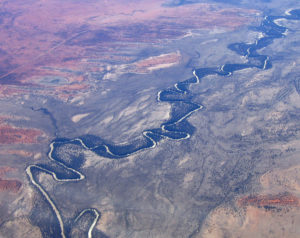
Just give us a sort of sense of scale. So more Water flows through the Amazon in a day. Then flows in the Murray in a year. That’s a massive difference. I’m very dry amount of resources.
Scott Hamilton
Scott Hamilton is a researcher and policy advisor. He just released the book he wrote with Stuart Kells, “Sold Down the River.”
If irrigation on the Murray River has a 70’000 years’ history, the first modern attempt at it was found in the 1880s, when farmers fought a severe drought with “Water Trains.”
Irrigation on the Murray started in the 19th Century
This led to the building of the first reservoirs, weirs, and channels under the direction of Alfred Deakin, Victoria’s chief minister at the time. The entire Water Supply and Irrigation scheme was inspired by Deakin’s investigation trip in the US, emulating the approaches he had discovered in Arizona, California, Colorado, Kansas, or Nevada.
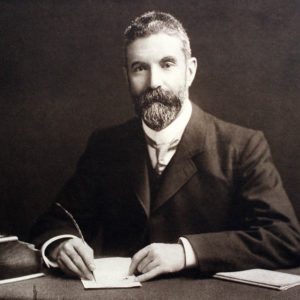
His Irrigation Act aimed at maximizing the yield of the Murray-Darling’s best soils, located upstream of the Barmah Choke, a kind of natural bottleneck that separates the River in two.
Deakin’s legacy wouldn’t stop with the irrigation infrastructure and water allocations. He also warned everyone:
“The right to use water should inhere in the land to be irrigated, and water-rights should go with land titles.”
Alfred Deakin
That’s common sense, come on. Who would go against this!
Hahaha…
First (informal) examples of Water Trading
For a century, things stayed as is, with farmers irrigating their parcels with their allocated resources and punctual arrangements.
At that time and leading up till probably the 1970s there about there was some informal trading and one of the classic examples that one farmer may have had a little bit water left over from their irrigation plot, and another farmer needed a bit more. He’d say, well, you can have a couple of mega liters of Water for a slab of beer!
Scott Hamilton
Yet things were about to change with the 1980s.
How the 1980s changed the Water Trading Game
Ah the 80s! Michael Jackson’s decade…

… the first Star Wars trilogy and…
Ronald Reagan, Margaret Thatcher, Milton Friedman, and free-market economics.
Everyone was on the bandwagon of thinking that markets are fantastic.
Scott Hamilton
And if markets are fantastic, why not trade Water as a commodity?
Water Trading started in the US
California had been the first-mover by launching its water trading market in 1982. It would be followed in the US with Colorado river water trading in 1988 – a glorious year – while Down Under, water trading began in 1983 in New South Wales and South Australia, and in 1986 in Victoria.
On the paper, it was very promising. Suppose you are a Murray-Darling farmer. Unlike your neighbors, you invest in state-of-the-art irrigation tools so that you end up needing much less Water and have some of it left on your allocation.
You can now go on the market, sell that surplus to your neighbors, and cover your investment costs for upgraded irrigation.
Along the same line of thinking, if you had to choose between various possible applications of your water allocation, you would for sure pick the most valuable one to maximize your Return on Investment.
What’s not to love about that?
A slow start in Australia
For two decades, it seemed to work quite smoothly, even if the market ended up being underused. By 2000, less than 10% of Basin irrigators had ever conducted a water trade.
But a revolution was around the corner, with the Millenium Drought.
The millennium drought was the worst drought we’ve ever seen. And what that was the beginning of is the impact of global warming and climate change. By going into the market and going harder and quicker and further than any other nation, we thought that we’d be able to deal with this problem.
Scott Hamilton
Remember Deakin’s recommendation not to separate Water from land? Well from 2004 on, this was history. Water rights were unbundled into four separate components. In 2007, Water was officially uncoupled from the ground in Victoria, followed by South Australia in 2009, while it took New South Wales 14 years, from 2004 to 2018, to fully cut the cord.
Water Trading takes off when the Market gets deregulated (or unbundled)
God was it efficient! By 2015, 78% of Basin irrigators had now conducted at least one water trade!
Right. But that still doesn’t explain how a Canadian pension fund ends up being the largest owner of Australian Water.
What is probably more of a problem, was to allow other players to come into the water market. So it’s not just farmers and users, which could trade that Water. Anybody could!
And of course that means that people who are very sophisticated – this was around the time of the boiler rooms and Enrons of the World. And they start to think: “Well, maybe I can have some arbitrage about this Water!”
Scott Hamilton
How this reminds us of a movie…
In “The Big Short” movie, Michael Burry predicts the collapse of the US housing market and makes a big profit over it. But if you’ve been watching the movie’s ending attentively, you must have noticed this: all his investing is now focused on one commodity, Water.
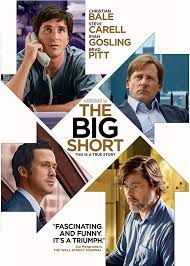
This is actually not fiction but a true story and many bankers, hedge funds, and traders have been massively following that advice.
In the case of the Murray water trading, Banks were even seen as a positive influence at first, as they would act as liquidity-providing middlemen.
But that didn’t last.
What are these finance professionals doing in an irrigator market? Well, what they know best: buying when the market is low and selling when it’s high, this “Arbitrage” Scott mentioned seconds ago.
We changed the market fundamentally from being a natural resource market into a financial commodity market. We’ve created this opportunity with literally billions of dollars for hedge funds. One of the worst things about this part of the story is that they didn’t regulate them.
Scott Hamilton
Is Water Trading similar in Australia and in the US?
When it launched, the Australian water market wanted to emulate the US approach. Indeed, you can go to Wall Street and… actually buy water?
Actually, water is not traded per se on Wall Street. What is traded is its future price. Let’s say you take a micro-brewery in California, and you need water to craft your beer. You can go to the Stock Exchange and get a water delivery contract. You secure the price of your water to be delivered in two years.
Nicola Lei Ravello
Remember Nicola Lei Ravello? He’s the founder of White Stag Investing.
So you see, the US was confident enough in the markets to trade water, but still placed some limitations, as you don’t directly trade the physical good, and as water and land never got unbundled.
But those limitations literally exploded in Australia, as everything that was left in terms of regulations gradually vanished after the unbundling of Water from land. For instance, interstate transfers were eased up then deregulated.
And water trading didn’t happen just on one platform, but on over 30, with 70 different water market products available and off-market trades over water brokers to spice things up.
Can a Water Market be fully free?
You can have markets, and that can be useful, which we would still say now. But you’ve got to have integrity behind those markets. You’ve got to have fair playing fields. You’ve got to have good information.
Scott Hamilton
And was that the case on that market? Not at all.
On one end, you had professional traders armed with bots, tools, superior experience and information, and deep pockets. On the other end, you had farmers, with desperate water needs.
Suppose you’re a trader, and the market is at an all-time high. Would you buy Water? Of course not. But now suppose you’re a dairy farmer in that same high market, and your cattle need Water now; otherwise, they die. You have to buy Water, there’s no other choice.
Hedge funds can push the individual farmer or the irrigator to their maximum willingness to pay. And they can do that every time.
Scott Hamilton
Is Water and Stock Trading comparable?
Now there’s a difference between Water as a commodity and your regular Coca-Cola share on the stock exchange. You can’t just store it virtually in your wallet.
This leaves you with two choices: leveraging the high market’s volatility – in the early years of water trading, price movements of 1’000 to 2’000% within a year were common – or bank your Water up, to sell it back later.
To do that, you now need to have a physical foot in the Murray River basin, and that’s how industrial-scale farms started developing in the lower part of the River, below the Barmah Choke.
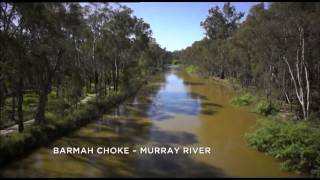
Between 1997 and 2018, the total irrigation in this area doubled to reach more than 81’000 hectares. Even more surprising, those farms started to extensively grow almond and olive trees – which also doubled.
How Water Trading reshaped the Murray-Darling River Basin
Why? Simply because an Almond tree won’t die from one day without Water. It may be a low-return crop, but it’s the perfect false nose for water trading, the cherry on the cake being that it allows at the same time to communicate around how you “green a desert.”
As a result, the farms above the choke started having financial difficulties, with the ever-rising price of Water. One by one, they began to close. But the same infrastructure and fixed operation costs, divided by consistently fewer farms, became an unbearable cost for the surviving ones, which in turn also had to close.
That devil’s circle totally changed the River’s equilibrium. Before that, you would have irrigation in the upper part, the River then behaving as a river on the rest of its course.
What happened as we started to artificially or move more Water from above the choke, up in these dams, down to below the choke, the amount of Water that had to get forced through this small juncture was more and more. And so we had this cold water pollution, which is not the right temperature in order for fish to spawn
Scott Hamilton
Low-Flow: a River Management mechanism
To understand how this exactly led to that million fish dying downstream, we have to understand a river-management mechanism called “low-flow.”
There were times in the year, where the river was fully dry.
Georges Walter
And so, fishes were dying every year on the downstream section.
Georges Walter is the Environmental Director of the Haut Rhin Departmental Council; he’s in particular in charge of rivers and dams. And for 33 years now, he’s my dad.
As Industries needed that water to cool down their processes, they also had to stop. Treated wastewater discharge was also becoming problematic, as, without dilution, it was poisonous for aquatic life.
To avoid this, we’re adding water during the entire dry season, which usually lasts from June to November. But of course, you need to stock this water up before!
The concept of low-flow is not new, but what changed is our sensibility to aquatic life. So low-flow became more important because society expects better environmental treatment today than 50 years ago.
New regulations were introduced as well, but in our case, we didn’t wait for them. There was a collective will to invest in bettering the environment. Let’s be honest as well: if we were only driven by financial indicators, nature and the environment would probably not be privileged.
Georges Walter
How Australia forgot to plan for Low-Flow
The thing is that when they first designed the Murray-Darling Water Market, the regulators didn’t include a water provision for low-flow. They hoped the market would regulate itself, and sufficient amounts of Water would keep flowing at any point in time.
When they realized this wasn’t happening, they entered the market on behalf of the environment, spending, for instance, 3 billion dollars in 2008 to buy Water and water licenses.
The Murray-Darling Basin Plan followed in 2012, with a 13 billion dollars investment to recover another 2’750 gigaliters for the environment.
But already in 2008, senator Barnaby Joyce expressed how limited of an impact this would have:
This purchase is probably not going to do very much if anything at all to relieve the pressure on the Lower Lakes.
Barnaby Joyce
Aka exactly where those beautiful Murray Cods ended up belly up…
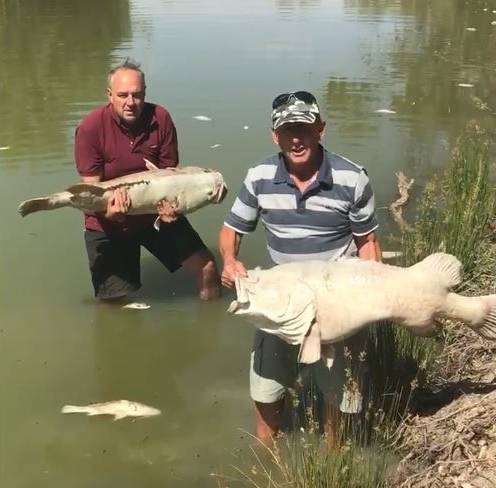
How fish (and birds) suffered from Water Trading
Without sufficient environmental allocations, the River had stopped flowing, which spurred a blue-green algae bloom. When cold Water from the uphill dams reached these areas, the sudden change in temperature killed the algae, which dropped to the River’s bottom and sucked all the oxygen.
The trapped fishes had nowhere to go and suffocated in place, killing one million of them, according to the official count.
Between October 2019 and May 2020, over 65 fish death events like this one have been reported to the Basin authority. And this extends to the overall food chain, with waterbird populations reduced by 70% over the era of Water Trading.
And just when you think, it couldn’t get worse, there was still another consequence to the shift in river flows:
The other sort of issue that happens is that you actually have to force a lot more Water through these wetlands and this part of the river system. And that has massive impacts in terms of scouring of the banks. The local indigenous group in this area had to move a burial ground, because the bodies started to come up…
Scott Hamilton
Conclusion
So what’s to remember from that Water Trading story?
Well first, that apparently, Michael Burry was right again when predicting that Water would be the new Oil. If you had invested in Australian Water ten years ago, you would have made a similar +500% than with the SubPrime crisis in the Big Short.
Then, that this profit, for some, came at the expense of the environment, the economies, jobs, and lives of traditional farmers, and the secular equilibrium of a river basin.
And finally, that it’s not over, as everyone, you and me included, can still enter that market as we speak, even from the other end of the World.
In “Sold Down the River” – Scott Hamilton and Stuart Kells close with four problems that shall be solved to correct that market:
- It must reduce the tendency towards corruption
- A new water model needs to address the stark power imbalance between groups of participants
- The water model needs to reflect the multiple values of Water
- a new water model needs to recognize the tendency for financial returns to dominate economic ones in the Basin
Then, Water may effectively end up flowing to its best use. If not…
The money and the Water flow to where the most money could be extracted from the system.
Scott Hamilton
Full Transcript:
These are computer-generated, so expect some typos 🙂
Antoine Walter: Hi, Scott, welcome to the show.
Scott Hamilton: Hello, terrific. To be here.
Antoine Walter: What I have to say, I’m excited to dive into today’s topic because it’s fascinating by many aspects, but I’ll keep a bit the expectations for now. And we’ll start with the postcard and you’re sending a postcard from Melbourne Louis.
Scott Hamilton: So I’m here from Melbourne, which is the capital city of the state of Victoria in Australia down under, um, has been nominated in the past as the world’s most livable city.
And as recently got a new title, which is the place to have the longest lockdown in the world over hundreds of days in lockdown. But the great news is we’re about to come out of lockdown at the end of this week. So our, we won’t have to stay at home and only leave for four or five reasons. So it’s going to be great to be out and about
Antoine Walter: link between the fact that you were in the longest lockdown in the world.
And the fact that you wrote a book. Yeah,
Scott Hamilton: well, probably helped. I would say they’ve said that book sales have actually gone up quite a lot during the COVID era because people had more time on their hands. And it did allow me to focus on doing a little writing during that period of time. Also moved, doing zoom calls as part of the interviews and phone calls and those things.
So, yeah, it wasn’t wasted. Certainly.

Antoine Walter: We’re actually talking about the topic of the book. There’s something which I like to understand here. Really. That’s going to be a questions for the muggles, so sorry for that. But you’re explaining how you were intending with your culture, to, at Kels, to dive into bipartisanship and examples of bipartisanship.
And you ended up having a book about water trading and about the Murray-Darling river Besson. What’s the link between those.
Scott Hamilton: Yeah, it is really a fascinating story. So Stuart Kels and myself. So Stuart’s my co-author. We started out researching bipartisanship in politics. So looking at all the reasons why different sides of the political divide come together and when that happens and when it doesn’t, because one of our thesis is that if we’re going to solve, we can problems like climate change.
We’re going to have to have more bipartisanship, not less or multi partisanship. That actually is what we were sort of working. So as part of that research, we were interviewing politicians and, um, key players. And one of the things that kept coming up as both an example of when it has worked and we’ve seen some progress made and when it has failed and failed really badly is the Murray-Darling basin, which is the biggest natural asset in this country.
It is the most important river system in terms of the country, in terms of its size. I think you might be interested in its size. It’s bigger than France. So to give you a scale of what we’re talking about, um, it is literally huge
Antoine Walter: talking of this scale. Let me just try to understand that a bit better. You mentioned that you are in Melbourne, which is the capital of one of the states.
And one of the things to know, I guess, about Australia is that it’s a federal government and that the Murray-Darling river basin is across several states, right? Yes, that’s correct. And that plays a role in the story we’re going to tell, I
Scott Hamilton: guess it absolutely does. And the fact that we’re a Federation based on the Westminster system is really important and how the states came together back in 1900.
And one was when we became a federated country. Um, and we had a Commonwealth government, which was then went on one of the big issues at that time was what the powers of the Commonwealth government, the federal government were going to be versus the powers of the states. And there were huge fights over this.

And one of the big fights was over water who controlled the water. And in the end, the decision was made to leave that power, that vested power in our constitution with our states. So that’s Victoria, new south Wales, Queensland, south Australia, and now the Australian capital territory is also part of the system.
Just
Antoine Walter: before we dive into the topic of water and water trading. You know, I mentioned in our short discussion before recording that I had a discussion with another citizen of a Melbourne Mina Guli a couple of weeks ago. And I was just wondering if you’re a bit more interested in sustainable development and climate change down under, or if really it’s a coincidence.
Scott Hamilton: No, I think that, um, so Australia, whilst you would have noticed in the recent news media, that Australia is a leg art when it comes to action on climate change. So, um, we are not the leading country in the world. And in fact, there’s a big debate going on right now in Australia about whether we even commit to net zero by 2050, which all the other nations have already committed to.
And we’ve got relatively weak, 20, 30 targets. So we’re generally a leg out. But the other thing is though that we actually, because we’re the driest inhabited continent on the world, in the world, So we’re extremely dry in terms of rainfall and water availability. It means that we also see the brunt of climate change really quickly, and the sorts of severe droughts, bushfires, and extreme weather events that come with climate change.
He’s Australia really hard and have already started to, and we had our black summer, um, a couple of years ago that you would have no doubt heard about and also massive droughts in terms of the Murray-Darling basin. So all of those issues mean that the challenge for having sustainability, particularly with water, but also other natural resources was really critical to this country.
And that’s why you see that a, a lot of effort going into trying to manage and share and make best use of what little resources we’ve got in this
Antoine Walter: place. So his crush should be the surface about this Murray-Darling river Besson. You said it’s bigger than France. And I took a couple of additional facts from your book.
I’m not trying to be more clever than I am. So the Murray darling river best in produces 40% of Australia’s food. It holds 3 million inhabitants. It flows through those three states that you mentioned, and it creates $24 billion of yearly agricultural value. I don’t know that figure by the waist before or after this trading thing.
That might be something we discussed at some point, but you mentioned Australia’s independence in 1901. And you mentioned these early stages of water management in the book. You show her water was central to all of that, but to which extent was it like the head topic on which everything else was built around?
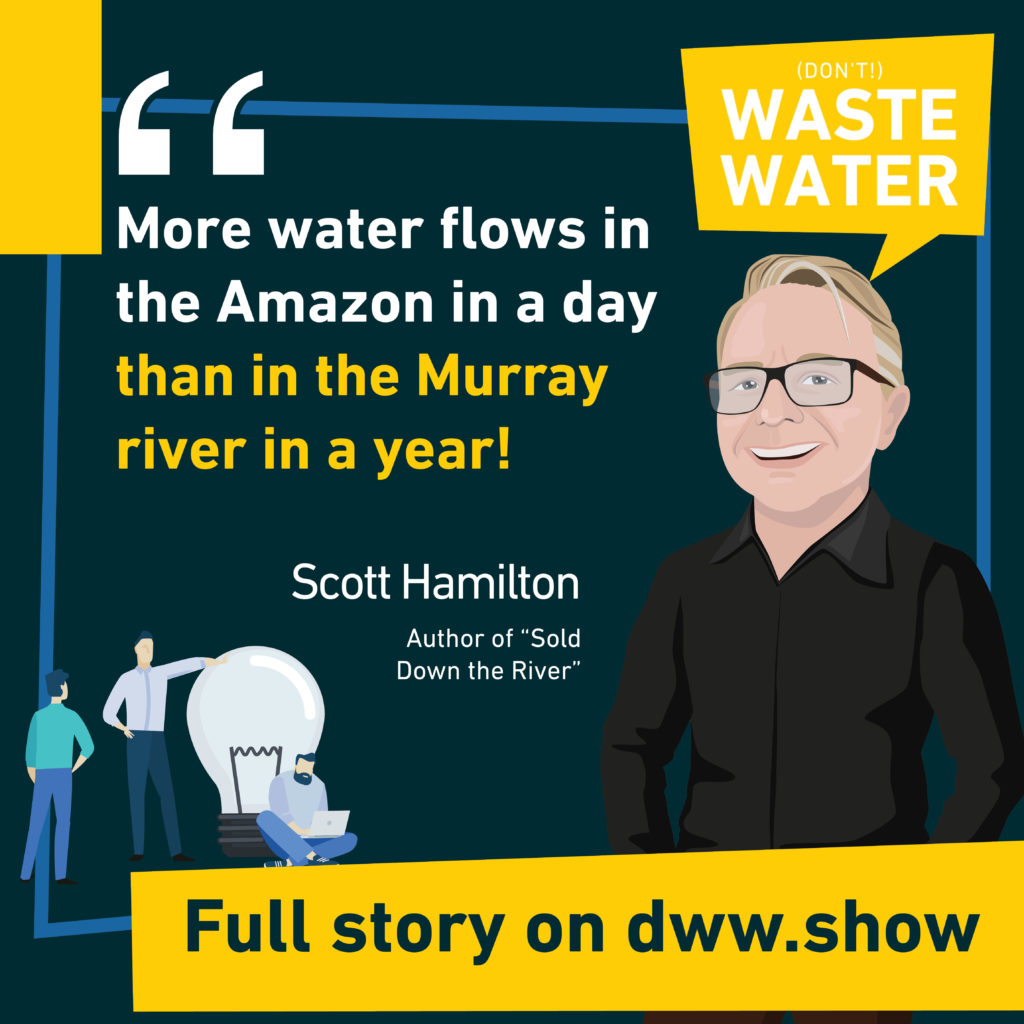
Scott Hamilton: Yes. So it was a, uh, it was a critical topic. And again, being the driest inhabited continent and in terms of the Murray river, that is one of the biggest of the rivers part of the Murray-Darling basin. So, and just give us a sort of sense of scale. So more water flows through the Amazon in a day. Then flows in the Murray in a year.
That’s a massive difference. I’m very dry amount of resources. The first thing to sort of understand, and a long history of indigenous peoples in this country, I had a very close connection with water and being able to use the, this limited resource to feed themselves for literally 70,000 years or a long history.
And we go into that in quite a lot in the book as well, because that comes important. And particularly when we start talking about the. And so the sort of sense I’m giving is that water here, um, in particular is an extremely important resource. And that was known at the time by, um, a lot of the white settlers, which is who, the people that drafted the constitution back in 1900 and where the debates happened.
And as I mentioned, so water was one of those key debates. So largely they gave up the power of taxation, foreign affairs and those sorts of things and defense to the Commonwealth, but kept, um, particularly the water power in particular. There’s a specific section in the constitution, which talks about it.
But also though, so those service delivery powers remain vested in the states at the time. And that caused a lot of challenge in terms of how we’re going to manage this highly interconnected Murray-Darling basin in particular. So this the most important of our natural resources covering those four states plus a territory and having to work out how the power was going to be shared.
And the debates that sort of followed
Antoine Walter: now that you explained that I start to understand why at the end of our story, there will be several markets just because there are several states. So I guess two things now clicked in my head. So it’s not too bad. It means that my brain sometimes works a bit, but let’s start with the beginning of that story.
You explained that water trading, which is going to be our main topic for today, what a trading started quite informally in the 1960s. What was its shape at that time? And why did the authorities think they had to evolve that into a more structured approach?
Scott Hamilton: Yeah. Sure. So these are fascinating stories. So post-World war.
One of the ways that we as a country saw, um, in terms of job growth and economic growth was to build major water projects. And you may have heard about the snowy hydro electric scheme, um, which was a massive nation building scheme around this time. And essentially that was designed to harness what resources were available in our snowy mountains and use that to supply electricity, but also to provide irrigation to the nearby areas.
So that was a very much focused. So we sort of talk about this was the, this was the rain of the engineers. Sir John Monash. And these people were the ones that were really making the big decisions in this country. So now elsewhere end. So when you, at that time and leading up till probably the 1970s there about there was some informal trading and one of the classic examples that one farmer may have had a little bit water left over from their irrigation plot, and another farmer needed a bit more for, to put in his rice crop or.
Cotton crop or whatever it might be. So that he’d say, well, you can have a couple of megs, couple of mega liters of water for a slab of beer. That’s 24 cans of beer to stuff. Um, so that was, there was a sort of first examples of water trading that we saw. Um, and then up until the 1980s, and that’s when it starts to get very interesting, cause that’s random at the time of Thatcherism and Reaganism and free market economics.
And so everyone was on the, I think on the bandwagon of thinking that, um, markets are fantastic. And what we want to see is small government and lots of free markets and markets were going to be the answer to our problems. It was going to be the invisible hand of Adam Smith that was going to solve our problem.
Yeah, as the story goes, which we’ll get into, but Adam Smith was very, and this was back in 18. Hundreds was very wary to say, well, you can have markets and that can be useful, which we would still say now, but you’ve got to have integrity behind those markets. You’ve got to have fair playing fields. You’ve got to have good information.
You can have good compliance, all these other things to ensure that the market was going to at least give you the outcomes that you were desiring.
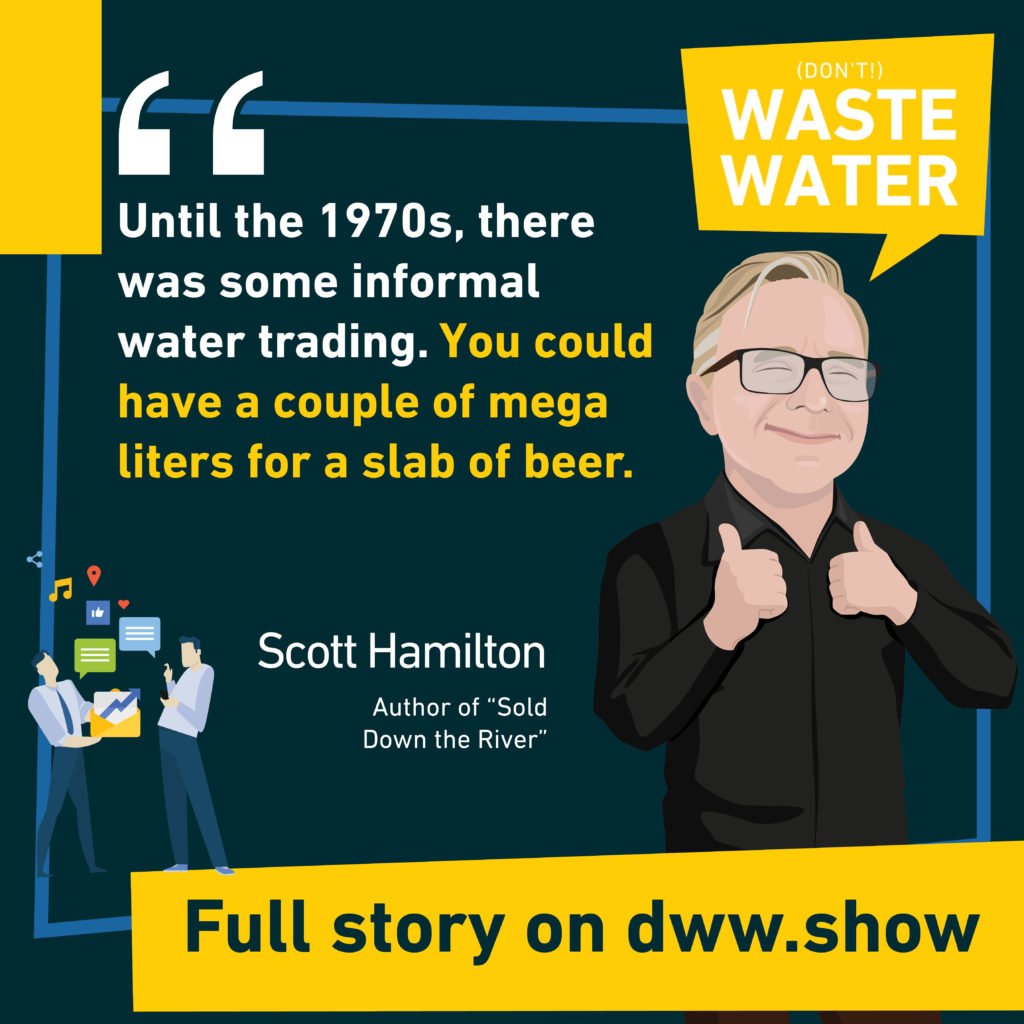
Antoine Walter: But even at the top of that hype in the eighties of the Reaganism and the Thatcherism and this liberal approach of economy, the countries, which were going into water trading, didn’t go to the extreme that Australia would go.
So what is the reason for Australia to be in this case? The best of the liberalism of pupils, if I may say so.
Scott Hamilton: So, and this is again a fascinating part of the story. And even now we are still being looked upon by Colorado in terms of what we did in terms of the water markets and some profess that we are the most advanced in terms of our water markets in the world and those things.
But we think that’s missing a major point. So that context that we were talking about, so this idea that markets are terrific, and we want small government, lots of free markets and free market in enterprise economic rationalism, I suppose. There’s another way to think about it. Um, was it the same time that we were to experience another one of our massive droughts?
So every so many years, I think we talk about the Noah effect in terms of the water and climate system. In this part of the world. In every certain number of years, there would be a massive drought and what we were coming up against and. At the beginning of in this time. And we, and it was to last sort of over 10 years was the millennium drought, which was the worst drought we’ve ever seen.
And what that was the beginning of is the impact of global warming and climate change starting to see major shifts in how water systems. So at this time where we had a great enthusiasm by politicians, by policy makers, by lots of community groups, really fascinating that both the environment groups, as well as the farmers end up buying into this approach.
So it was then was getting on the bandwagon or drinking the Kool-Aid was one of our ways that we would put it. So everyone was on it and we had this massive drought. So it basically, you I’m putting it in sort of very simple terms for the audience and just to get across. So this massive problem and what was seen as an elegant.
Which was the market. So by going into the market and going harder and quicker and further than any other nation, we thought that we’d be able to deal with this problem of. And I’ve ran a very over allocated resource, which was causing major impacts and on the bottom of the Murray-Darling system. So this is this massive system of rivers and histories, and is what is known as the likes down at the bottom, um, in, in south Australia, um, which are REMS, are weight lens and these lakes, and this they’re very hotly contested part of the world by the way.
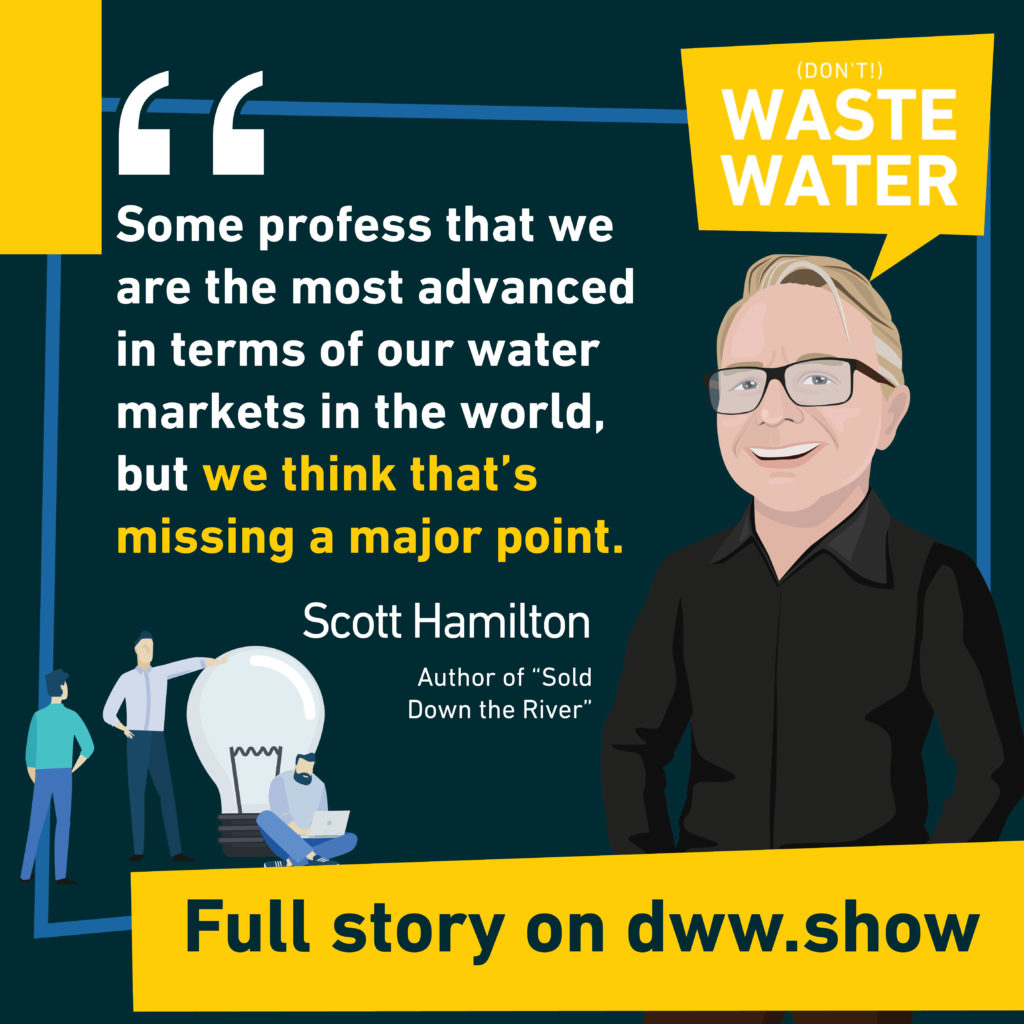
But these likes were basically stopping flying to the sea and it was having major impacts on the wildlife and bird population and all those things. So things were the things that the country was being confronted with. And so this elegant solution of water markets was what sort of was make things happen, I think, quicker and faster than elsewhere.
Antoine Walter: So that means that the idea there was that if someone was to farm sustainably to use less water or to modernize the way they irrigate, they would be rewarded because they would have a bit more of water that they could then sell on the markets. So on the paper, that sounds really perfect. Yes. So I wonder how things can turn bad from there.
Scott Hamilton: Yes, exactly. And we’ll go into this, uh, quite a bit in the book is part of the hour. Um, one of the problems was the Mac was never really designed what specific outcomes it was really looking for. And that’s one thing we think needs to happen now, but broadly the concept or the public policy principle was that using a market based mechanism, we could make sure that this diminishing resource and this amount of water would go to what was going to be its best use, as you were saying.
So it’s most efficient use or those things are where it would be most valued and provide the biggest benefit to the economy and to the country and the people within the community. That was what the idea was behind bringing in, going in hard in the most.
Antoine Walter: The fascinating thing is that you’re demonstrating the boot, how it’s almost the opposite that happens that somehow water got to where it doesn’t make much sense and the best use place just right out.
But before jumping into that, that’s just kind of jumping into conclusions. You show in the book, how they are two turning points in the design of that market, which can be traced back as the root cause of why it went by it’s bad. And the first is that the land and the water were disconnected. Yes. And that sounds so much as a bad idea, that they don’t understand why that decision was taken at first.
Scott Hamilton: Yeah. So this was a critical point. And let’s go into that a bit more in a minute, but going back to that discussion, which we were talking about in 1900 and or for deacon was, um, who became one of our first prime ministers in this country was an in very important politician in this country actually traveled to California.
And that’s where he learned about this idea of these irrigation schemes and how you could encourage development, those sorts of things. And he came back with the Chaffey brothers, as it turns out in terms of establishing the first irrigation scheme, which was up in the milk Mildura area and the Renmark area, which was sort of at the border between Victoria and south Australia and new south Wales, that’s sort of part of the world.
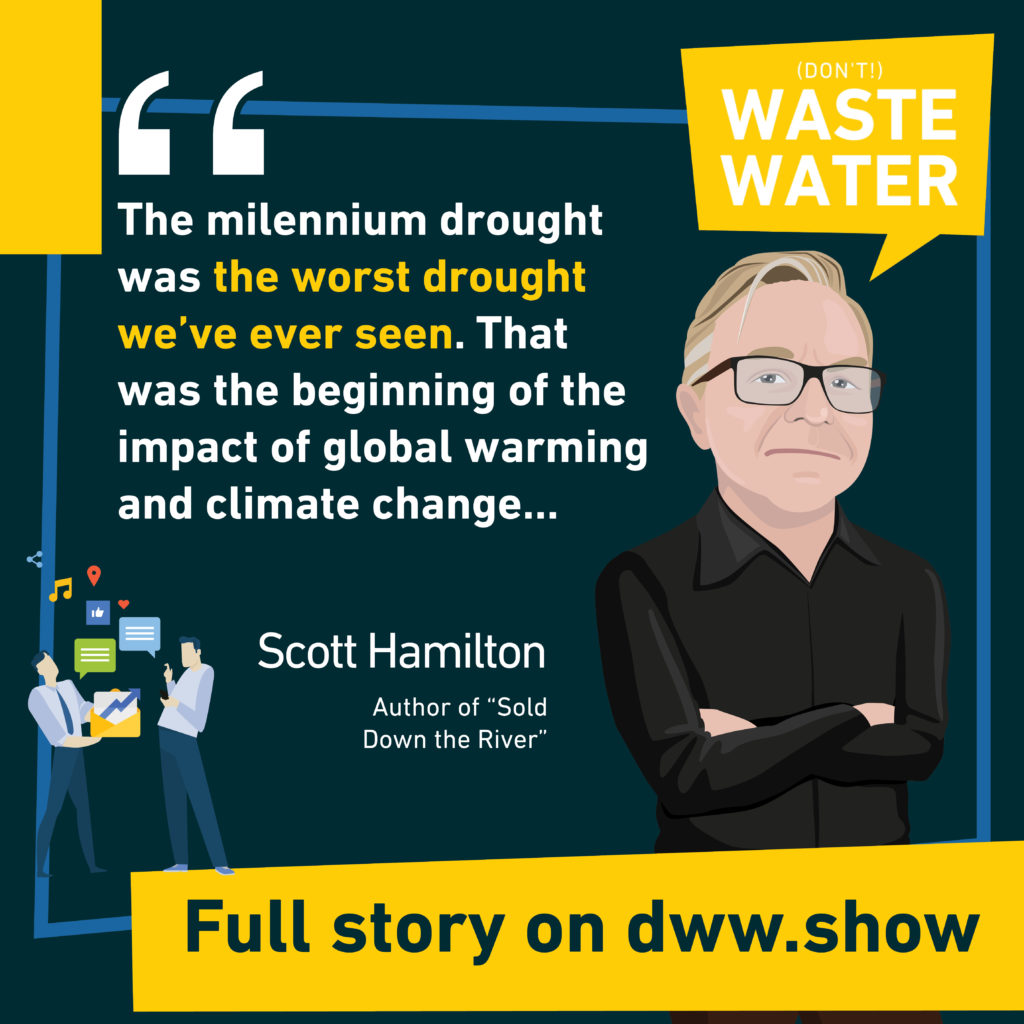
So he came back to this idea, but he warned as you rightly sort of said, we should never separate the water from the land because he’s concerned was that would allow. Profiteering and the Nepalese and other powerful players to come in and take advantage of the farmers and the irrigators and the other water users.
So he warned against that now, in terms of making, making the market, the Waterman. One of the first things that that was done was actually to disconnect the water from the land. So we call this unbundling is what gets described as we actually think that that in itself wasn’t necessarily a bad thing provided there weren’t sufficient rules around it and ways to manage that.
So let’s just take that for a little bit further for a minute that if I’ve got a farmer within a valley Saya, so it’s within using the same resource flying the same sort of areas and like that farmer with a slab of beer that I was talking about has a bit of water left over one season and the farmer down the road is planting.
Something else could use that water. Well sort of make sense to be able to allow that trade. So that in itself, we don’t think was the major problem. What is probably more of a problem. And then it gets worse, was the actual allowing other players to come into the water market. So it’s not just farmers and users, which could try that water.
Anybody could try that you could own and trade that water now. And of course that means that people who are very sophisticated and this was around the time you think about the energy market and the boiler rooms and Enrons of the world. So this is the same era that we’re now into starts to think. Well, and maybe I can have some arbitrage about this water.
And one of our key findings is that really what we created was a paradise for our arbitrage. So basically where they could find wrinkles in this market. And it’s not just one market, like there’s a report that, um, in the recent work that our competition commission did when they did an inquiry recently there sort of one broker was monitoring, monitoring, monitoring 30 websites.
So 30 different. So there’s not just one price as the point that I’m trying to make here. So there’s multiple prices, multiple valleys, multiple different types of water rights. So these are real provides what we sort of would describe as wrinkles in the markets. So places where someone with better information, more speed, more market power can take advantage of.
Let

Antoine Walter: me just make a point here for the stupid, which is hear me in that case. Arbitrage is this process of buying something at a certain price, with the intense that the price is going to rise, and then you can sell it at a higher price. I mean, it’s the traditional trading approach. And what you just said is just crazy 30 different platforms where you can trade water.
I mean, that’s just deathly. If you’re a farmer or a no maturer, you have no chance to win against a professional, which can just leverage those 30 platforms and putting that also into context. The market was launched in 1989, right? Yes.
Scott Hamilton: That was a real key point at the time.
Antoine Walter: At the time there’s the internet.
There’s no democratised tools where the basic farmer could stand a chance against the professionals. So what you explained. It’s not the burning, the water from the land, which is the critical thing you say, it’s letting those other people enter. And that’s something we should explain in details within the book, how a big amount of water in Australia is owned by banks and quasi banks.
And they were letting the markets because they were supposed to bring liquidity. And you show that it’s rather the opposite. I mean, again, it’s easy having seen the history and having read your book to say that this was a stupid decision, but still, it really sounds if you take a bit of common sense, like a stupid decision, why was it nevertheless designed that way?
Do you have an explanation for that?
Scott Hamilton: So I think again, we have to go back into the, into what was happening in the world at this period of time and the. Philosophies of public policy and stealing in very much an era of let it rip, we would say, so this was in the time we were leading into the global financial crisis and that sort of period.
So lots of these ideas behind breaking up markets and enabling more and more trading and less and less regulation, which the global financial crisis was one of the key things that came out of that. And in fact, we talk about the big short, how the guy that features in the big short is investing in water now, um, as the story goes.
But, uh, so there was this view that remember that trowing was good. That it market was Gooding here, Huntley, and it would solve our problems, but there wasn’t much training going on at first. So we have this trading and as I mentioned before, well, now we’d done all this work and unbundling all the different components, the delivery rights, the entitlements and credit, this short-term and long-term markets and multiple different parts.
I nervous amount of work that had gone into it and not a lot of trading. So largely how do we create more trading where we invite other people in the love liquidity is, which is, um, sort of strange, um, play on words, of course. Um, but, um, so the banks and these other hedge funds into the market as a way of providing the liquidity, so of making more trades on the basis that, um, the value of the water would then be soon found and would go to its best.
Um, most profitable, which is what I did had to go, go to, um, but graduates best use. So that was the theory behind it. And so Australia 13, this is not just Australian banks. Is anyone in the world, banks and hedge funds into a market with the purpose of creating liquidity in the market? Well, that means that we changed the market fundamentally from being a market or a natural resource market into a financial commodity market, because you’re right, the point in which is now worth billions of dollars.
So we’ve created this opportunity with literally billions of dollars for hedge funds and. Smartest guys in the room or the smart, the boiler rooms to say, here we go. Here’s an opportunity, but what’s the, one of the worst things about this part of the story instant, then didn’t regulate them. So normally we would have very strong regulations about financial commodity traders, and we have sort of a, um, a body which was called , which is our Australian system, securities and investments commission that regulates the financial markets really is what their fundamental role is, but we purposely decided, okay.
As a country and as a, as a series of governments and decisions that will, would not regulate the players that were coming into the water markets, that that’d be not bound by the same sort of rules and regulation that you would phenomenal financial commodities. And at the same time, the value of water was steadily increasing and increasing and becoming more and more tempting to have these traders come in and play the market.
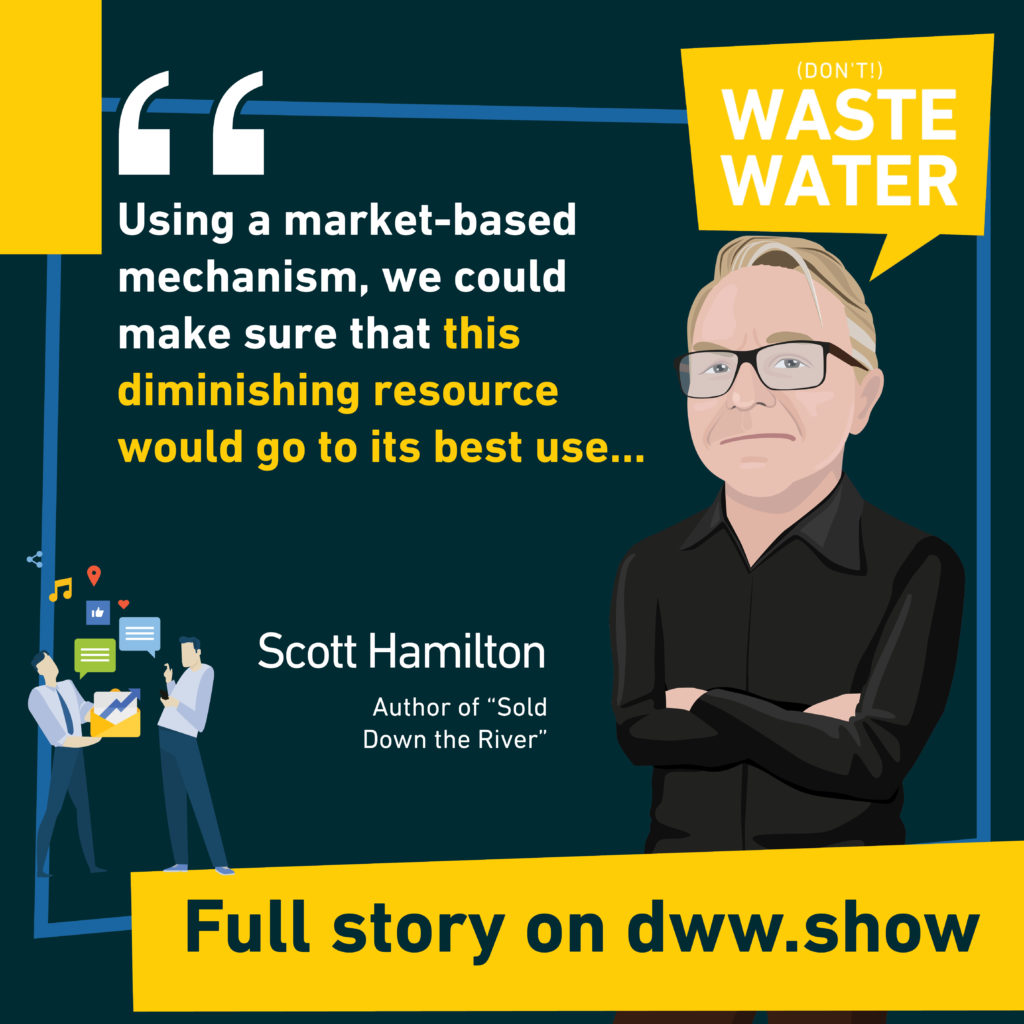
Antoine Walter: That means that the market was already designed in a very liberal way with this unbundling of water and land, with this freedom for everyone to enter the market. So with very low regulation. And on top of that, you explain the book, how, at the very beginning of that market, they were still some rules like from one state to the other.
You can treat more than I think 3%, if I recall, right. There were a set of rules, but even with that set of rules, it was already the most liberal market in the world. And then even those rules ended up being removed. That is an absolute confidence in the market. I mean, that’s really beyond what Adam Smith was saying.
Was it never seen as something quite a risky to do, to just remove any possible boundary and barrier to some extreme trading approach?
Scott Hamilton: That’s exactly right. And, uh, so as part of our research, we’re sort of being, um, gobsmacked or flabbergasted by this is just crazy as what we were thinking and say, how did we let this happen?
And just again, decision after decision, but purposely, purposely not regular. This market in the way that it should be, and to actually take away any of those protections, such as you mentioned, this certain percentage, which could be traded between valleys. So as we sort of get into, we mentioned before, there’s not just one market, there’s multiple different markets, which are being played at the moment and you can try it across.
So different valleys and, um, you can move water and carry over water and make trades across these bellies. So if you know something better and quicker than everybody else, you can then play that market and start to manipulate that market. And that’s where we also saw the introduction of bots and technology.
So if you had the quickest computers, um, and the best algorithms, um, when there were key decision points or changes happening in the market. So one of the critical features, which is why the history of science important of the Australian history here is the Barma Choke. So it’s this very important part.
Of the Murray river, which was actually created by an earth movement sort of thousands of years ago, but it means there’s this choke point in this river. This is probably our biggest river in terms of most important. What one of our most important rivers, there’s this point that only a certain amount of water can get through at any particular time and generally the river.
So higher upstream is the where the largely the more productive, the more, um, the, the better soils. And I think that the designers expected that essentially that the money and water would flow upstream to above this choke point, but that’s not what happened. And essentially it’s flood below that choke point, which is where we’ve seen massive growth in the last, in the same period of time.

And I think it’s since 2000, there’s been a 1500% in almond. So we’ve seen these massive growth in both our almond andolive farms as it turns out and which are permanent plantings and take a lot of water. And what happened is that essentially the money and the water flow to where the most money could be extracted from the system.
And so we’ve seen, I massive shift in our agriculture and our farms closing up in the, above this choke point down into this below the choke, where it’s largely very Sandy soil. And in fact, in places in America, they wouldn’t that wouldn’t allow you to put plantations there. Cause it’s just not where you really should be putting irrigation when I’m doing those sort of things.
Antoine Walter: You mentioned at the beginning, that’s all of that was intended to have the best use of water. And the best use of water would be above the choke, which is kind of a bottleneck in the river. If I try to picture it. And that was also the place where all the irrigation infrastructure was already built and was already available.
And instead of that, as the land was cheaper dome the chalk, it allowed the creation of those mega farms and to mega farms had also these ability to store water and to be playing on the markets because they had a bit more flexibility. Yes. So you have that to river. And again, I think your image is very important here, which has a yearly flow, which is below the daily flow of the Amazon river, just to keep that context.
And it’s just a massively used to grow almonds, which doesn’t sound like the most clever use of water. But before we go down that rabbit hole, I’d just like to understand something because we are seeing water, but if I get it right, there are different types of water which are traded. And that is the second of the turning points you were in identifying in the book.
Can you just explain us, what are these different components of the water rights that you can have on that market?
Scott Hamilton: Um, so, and it is complicated and it’s even complicated across all these different states and these different territories in terms of the rules and what things are called. But largely we have this unbundling I talked about, is it, what about separating and breaking up parts of the water components?
So we’d have permanent title. So some farmers would have a right to a certain permanent, um, amount of water. You’d have temporary entitlements. You would have delivery rights. And so you’d have a number of these different components and know what to use, right? So you have all these various different rights in these different components.

And which is important when we think about this, because then remember we’re not just trading water with EMA valley. We’re also trading across valleys to different valleys in different parts of the system as well, and multiple different parts of the rights. So going back into, if you want to take advantage of the system, the more complicated it is, and the more fragmented the market is, the more wrinkles you can then find that are arbitrage or as the pickers.
There’s another, um, example of, um, people trying to sell a product on one market and then selling it again to make a profit. And that’s largely what they do.
Antoine Walter: I think that brings me to kind of an elephant in that room, because you just said that if you would like to make the most profits in that market, that’s the way you would design it.
And everything we’ve said so far is like, why did they do that? Well, probably because they believed in the markets. Now, if I take another approach, another pair of goggles to look at that, I may think, you know, that’s, it was made on purpose, which is something that you show in the book. That’s maybe, maybe it was an attempt to corner the market.
Scott Hamilton: That’s certainly enable that to happen now. And our thinking even developed over the past few years, doing the research for the book was we, it sort of originally made the finding or our thesis was that one of the first things that we should do in order to fix the market or to, in terms of bring it back, um, delivering good outcomes from the economy, the social and environmental outcomes we’re looking for would be to say, in order to play in the market of the Murray-Darling basin, you should have some connection to water in use.
So in that case, the wall street trader sitting in Singapore, or in the Melbourne office, can’t play water just for the pure profit and game of it. You’ve got to actually be using that water to grow almonds or grow oranges or whatever. Or rice or cotton or, or fishing or whatever you wish. And that was what we were thinking here over part of the ability to corner a market relies on a few different things.
One is this ability to have, uh, to get these differences and use information, knowledge, power, speed. Okay. The other thing that we’ve came very advantageous to someone that wants to corner the market is this cap. So I remember back when we talked about, when we designed the market in both, this is really interesting that both the environment groups, as well as the farmers and the police all got in on board with this idea that a cap and trade system was a good idea at the time.
And we’ve now seen in carbon markets around the world, except for Australia that we took hours away. But, but so this idea that a cap and trade system, however, what that cap does, it provides a quite hard edge for a trader or someone wanting to corner the market, because what a someone in this game wants to do, they love scarcity.
Scarcity is their afraid. So we’ve got this cap, which is a nice hard edge, which. It’s a cap, that’s going down over time. And then the other issue, which we also then face is climate change and more droughts. And so when we have these massive droughts that California’s having right now, but we had just a couple of years ago.
So if you were wanting to make as much money out of the system, as you possibly can, then you love those droughts. And you’d love that. And you love climate change, which is really sad because it allows you to get bigger profits and take more money out of the system. And I’ll talk about that in a minute as well.

Antoine Walter: I think that’s one of the snapshots we have to take to better understand what we said seconds ago about these elements farms. If I get it right, if you have another Mont farm and you don’t water it for a couple of days, it’s not a big deal. Whereas if you have a cattle or a dairy farm and you don’t bring water to your cattles while they probably die, so you just cannot afford to have one day without water.
So if you were into the business of trading water and you need to have this kind of adjustment layer and farm is the perfect adjustment layer because the farmer up or down the choke, which has to bring water to his cattle is going to buy the water, whatever the price. So the scar CT is really playing in your favor and you have this almost false nose of being a farmer because you have the almond farm.
Scott Hamilton: And let’s really, um, it’s a really important point that you’ve just touched on there in, and we go into this. So it’s the ability of the trader. And the hedge funds. I remember a lot of these and farms and be giant agribusiness. I run off one, um, a lot of pension fund money. So we’ve got a lot of Canadian pension funds that aren’t a lot of our big films and those sorts of things.
Um, but also, um, hedge funds with lots of play money in terms of hundreds of millions of dollars to be able to play in this market. So the, the point I was sort of trying to get to there was that there was water traders that might have, uh, the cloak of a beet Yom and farm was those sorts of things. Or the backing can push the individual farmer or the irrigator to their maximum willingness to pay.
And they can do that every time. Because they don’t have the same on cost. So let’s use the example of even the, the rice farm or the cotton farmer. That’s got to prepare their field. They’ve got all the capital costs. They’ve got all those, that timing of plantings limited. They’ve only got a certain window.
They’ve got labor costs. And so they got, and they’ve got to make a profit out of their thing in order to keep their business afloat and thing where the trailer that sits in the other side of the computer screen doesn’t have any of those problems. So that enables that if this smart and we know they are smart, because remember we’ve seen them do it in other markets.
And that’s what this is. This is what they do. It’s their day job. They can push. Other side of the equation, their maximum willingness to pay every single time. And this is where the real sort of betrayal and tragedy of the system is. So what that means is that there’s nothing left on the table from this market, transactional, these transactions and thousands of transactions that’s going on.
And that’s extracting hundreds of millions of dollars out of the base. And every year in going into the pockets of wealthy banks and hedge funds. And that’s the really sad bit about this.
Antoine Walter: There’s an important piece of context here to give, which are two examples who given the book the first is that you see that even if it got better, at some point in time, the market was experiencing a black Monday crush every second day, in terms of magnitude, which gives you a sense of the volatility.
And the second fact, if I get it right, is that if you were investing $100 a decade ago in that market, right now, you have $600 in hands. So if you’re a farmer and you rely on water as some of the basic things, you need to just keep your business afloat, it means your direct costs were multiplied by six.
So those are the consequences of this water market.
Scott Hamilton: And let’s see, and that’s really, um, that’s one of the tragedies of what’s happened a couple of areas and we’ll know we’ll run out of time shortly, but they have a couple of, of really important areas or issues that we’re facing is the impact on the environmental outcomes, as well as the indigenous values that are also being really impacted in a real negative way.
And there’s a real disparity or disenfranchise of our indigenous people in Australia in terms of water rights and access to water. And those things as well is a really important part of this.
Antoine Walter: It’s an awesome transition. You’re offering me there because this is exactly where I wanted to go. The river has its economic services, which we discussed, but also its environmental services.
I mean it’s irrigating lens. It’s every gating, the biodiversity. And you have many aspects of that, which are really surprising to me. For instance, there’s the aspect of low flow. A river always has to have a certain amount of flow just in order to sustain itself and to keep having like fish life and everything inside that river.
And what I discovered in your book is that it wasn’t designed like that. So the government had to buy into the market. I think in 2008, to buy a bit of low flow, to give back water to the environment. How can it be that when you design a market in the eighties, you totally forget about low flow. Was this a blind confidence that water would keep flowing.
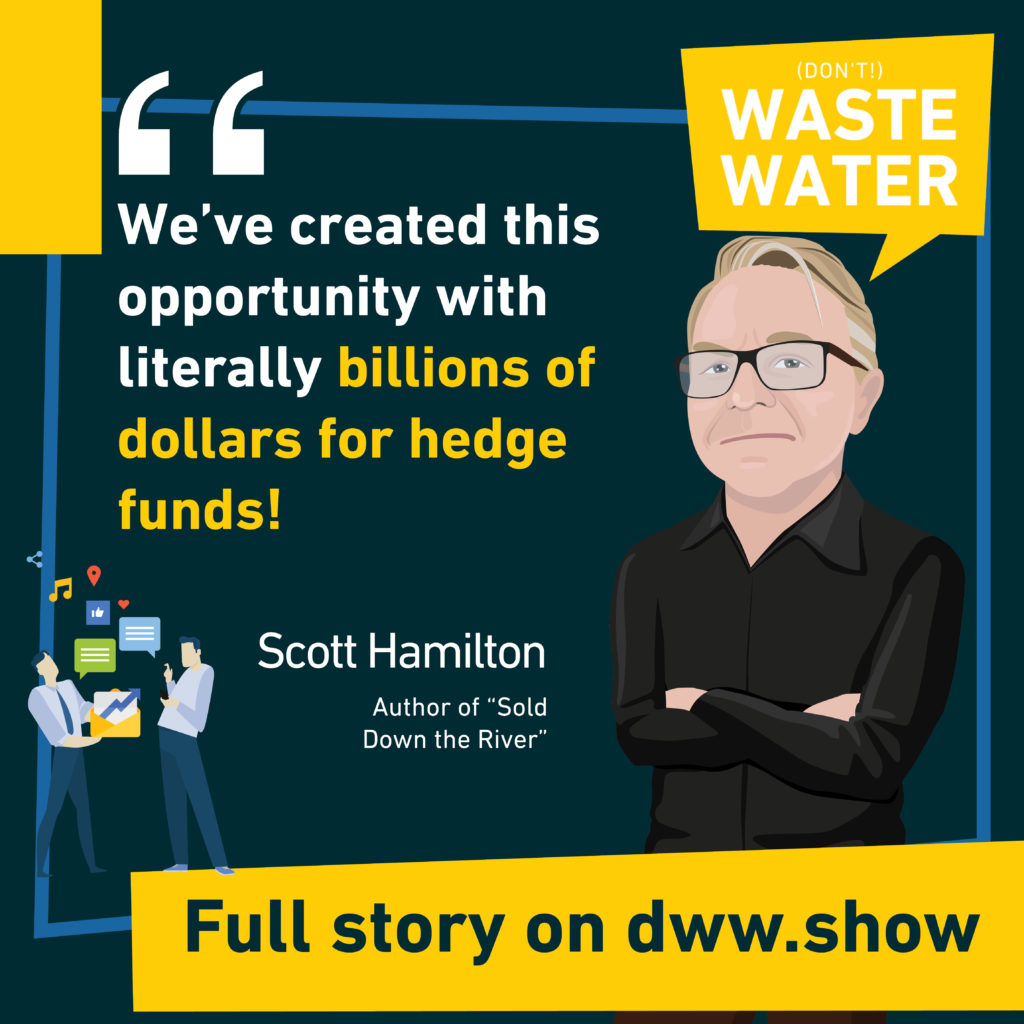
Scott Hamilton: Well, I think it was the politics was the fourth, one of the real problems in this debate. And, um, I think some of them described recently that when I talked earlier about the carbon, what was in Australia at the moment and the water was so they’re very toxic politics in our country. So it’s an arrogance to what gums are in America would be blinding, sort of why it’s sort of.
That concept across, and this is going back to one of those challenges. When we started to move massive amounts of water in this system around, remember we talked about the choke. So one of that things that changed over this period of time was up the top of the scheme. And we started talking about the snowy hydro scheme and up in the mountains where it’s flows, there’s largely a hinge irrigation, which is our golden valley, which is sort of one of our fruit bowls and payers and all those sort of things that the grown there.
And it says launch. The irrigation scheme. This is above the Choke. Well, above the Choke, using the water from the dams, which were built back in post-war that I talked about earlier, um, to guard their man and in the revenge start to be high, the rivers would then essentially start to behave, like what was a normal river.
And so fish could spawn and those sorts of things. And, um, the Murray Cod, the iconic Murray Cod, you might’ve heard about this. If you took 50 and a hundred years old and a massive fish, like you can’t see my hands, but they’re amazing. But then what happened as we started to artificially or move more water from.
Above the choke and up in these dams, down to below the choke, the amount of water had to get forced through this small juncture was more and more. And so we had this. What we I’m talking about is cold water pollution. So because you’re taking the water from the bottom of the dam and we’ll actually pushing it through this part of the stream.
It’s not the right temperature in order to, for fish to spawn and the, those things happen. So we end up with this cold water pollution, that’s affecting our biodiversity in endangered spaces. And the other sort of issue that happens there is you actually have to force a lot more water through this wetlands and this part of the river system.
And that has massive impacts in terms of scouring of the banks. And so there’s examples of, um, over a hundred year old trays and indigenous important trees falling into the river. And there’s a, an example in terms of some of the people that we talk to about how the local mob, the local indigenous group in this area had to move a burial ground.
Because the bodies started to come up this artificially putting so much water through in times that it wouldn’t normally be. And so we’ve done all this in 20 years and going back to that important part of the story at the beginning, the indigenous or the first nations of Australia had been managing the system for tens of thousands of years.

And we’re sending all those major impacts now. And then of course climate change. And when we talk about our diminishing any very low amount of water resource here, so in the past 20 years, the inflows into this Murray-Darling basin system have Harvard compared what they were for the past hundred years.
So, this is a massive shift in terms of member already very dry, continental, real issues. And let’s go and get sort of further again and over the next 10 years, by 2030, we’re likely to see another 10 or 15% reduction in rainfall, but in flows, that means up to a sort of quarter of regain with, so there’s some massive shifts in the availability of water due to climate change and more and more people wanting to use this limited resource as well.
You
Antoine Walter: mentioned at the very opening of the discussion, how the topic of sustainable developments may or may not be at the center of the discussion in Australia. What about the water market itself? Assuming everyone hasn’t read your book yet, which is a shame because I would highly recommend them to do so, but assuming they haven’t read it yet, what’s the warmness about everything you just described?
Scott Hamilton: Um, then he’s a real, one of the things which we’ve really, uh, worked to do is to tell this. Subject and issues in an engaging way, um, because it is not understood. Um, it’s Byzantine, it’s been described as a priesthood. So all those various walls and markets and things, uh, seen as overly, uh, very complex and people just don’t want to really know and get, get, get into this issue.
But when you realize what is happening in terms of the social and economic impacts that it’s having the environmental impacts and the cultural impacts really must understand and tell this to a wider audience, so that action can be taken to fix the market, because if we don’t all those bread juice flows and things, which I was talking about and just to gain another figure, and I don’t mean to use too many figures, but in terms of in those almond plantations, I was talking to.
Before, the more important that they are going to use in a year, these are those plantations I was talking about is more than a team available in the entire system in a drought year. So that just sort of gives you a sense of scale about what’s going on because as these trays mature are, of course they will grow.

They’ll use more and more water. And so what will happen is, um, there’s the hedge funds and the banks and the people that are making the hundreds of million dollars will say, well, we don’t need these anymore. And they’ll start to rip out those almond trees and those sorts of things, which actually is exactly what’s happening in California at the moment, in terms of the impacts that they’re seeing over there at the, um, which is what, which what happened here.
So we will have decimated all the form of a dairy farms and the farms up system and what we ended up having decimated the foams that are down the bottom of the system as well.
Antoine Walter: Well, that means that in terms of agricultural use of water, it was clearly negative. And on top of that, now the scar city is reinforcing and you showed how water scarcity speaks in favor of the traders.
And you’re saying that you want to raise the awareness on the topic so that it eventually gets fixed or bettered, but is there any political will to do so because you’re also giving some hints and recommendations on how to fix all of that. Do you think there’s a chance of some of your ideas getting picked up.
Scott Hamilton: I would want to think so. Um, so, and we have seen some improvements, um, in terms of the transparency of the market, particularly in some of the states, remember this is a fragmented market with fragmented rules. So I recently in the state where I am is in Victoria, we’ve just put in legislation whereby now the biggest water users, users, and water owners can be identified.
Um, and there’s a register of the people who own the water. So at least. No who owns water? Interestingly, um, just as an aside, the biggest owner of water in Victoria is a Canadian pension fund. That’s a, has a $1 company as the front, which is, I find quite fascinating this, the legislation or coming in. So individuals who are be owners of water will also be identified and they also working to regulate the brokers.
So it’ll be part of this whole system, other the brokers, which the real estate agents of the water system and the regulation of these places. So now seeing some improvements in that area. And I do think that the recent inquiry, which was made by our competition and consumer commission that I mentioned before, um, which the report went to the federal government, our federal government back in March, February this year, it was really damning on the whole system and said that it was really, um, needed major overhaul.
So at least we’ve got some of the biggest institutions now saying that there needs to be shift, perhaps that one of the most sobering sort of things of what was also found is that all this market manipulation and quartering of the market, which is done by the people that do that is the boiler rooms and the trading councils.
It’s not a lingual. So the ability to front run or manipulate the market and those sorts of things is not illegal. So getting back to that problem of that regulation. So in some respects, it’s not their fault. They do what they do. It’s the have to really make the shifts. And I think there’s a number of things which we think we could do by one is making it much more closer to watering use if you’re gonna play in the market, slowing down the market.
So this idea that we’ve got one trader, and there’s a really, um, example in the book where we talk about the farmer, who’s standing on the top of a tractor, trying to get a signal on their phone to make a trade versus the highest speed with kids gaming computers. Well, we’ve got to have a much level playing field and so slowing it down is another thing that we actually think could make a lot of difference.
This there’s some sort of fundamental problems though, in terms of how we make those big decisions of sharing and allocating work. Um, against the mini users, and this is not just the farmers and the environment sort of benefits, but also the people, recreational users and fishers and those sort of, um, users of the water and in indigenous users of water.
And we have to have a much better way of making that a collective decision about how we make these sort of decisions and outcomes that we’re looking to actually achieve. And we’re actually talking about things such as a citizens jury, um, as part of the book, as well as a different way to come to a decision.
And I think that Tim finery, he’s an author that launched that book for us. Uh, recently he said, well, I’m sure that that the citizens jury would come up with a very different answer to the one that we’ve got at though.
Antoine Walter: I just want to be sure. I understood you right here. You mean that in everything you were uncovering in the book, this cornering of the market, this fact that the farmer could call and say, I need water at $200.
And right now the water is at $100, but the brokers say, Hey, you want it as $200. Whether I sell it to $200, the fact that there were bots very early in the markets, which were just playing around with the choke, because it was opening only a few moments in the day. I mean, and that’s just some of the wealth of examples you’re sharing the book and all of that is one of it person legal,
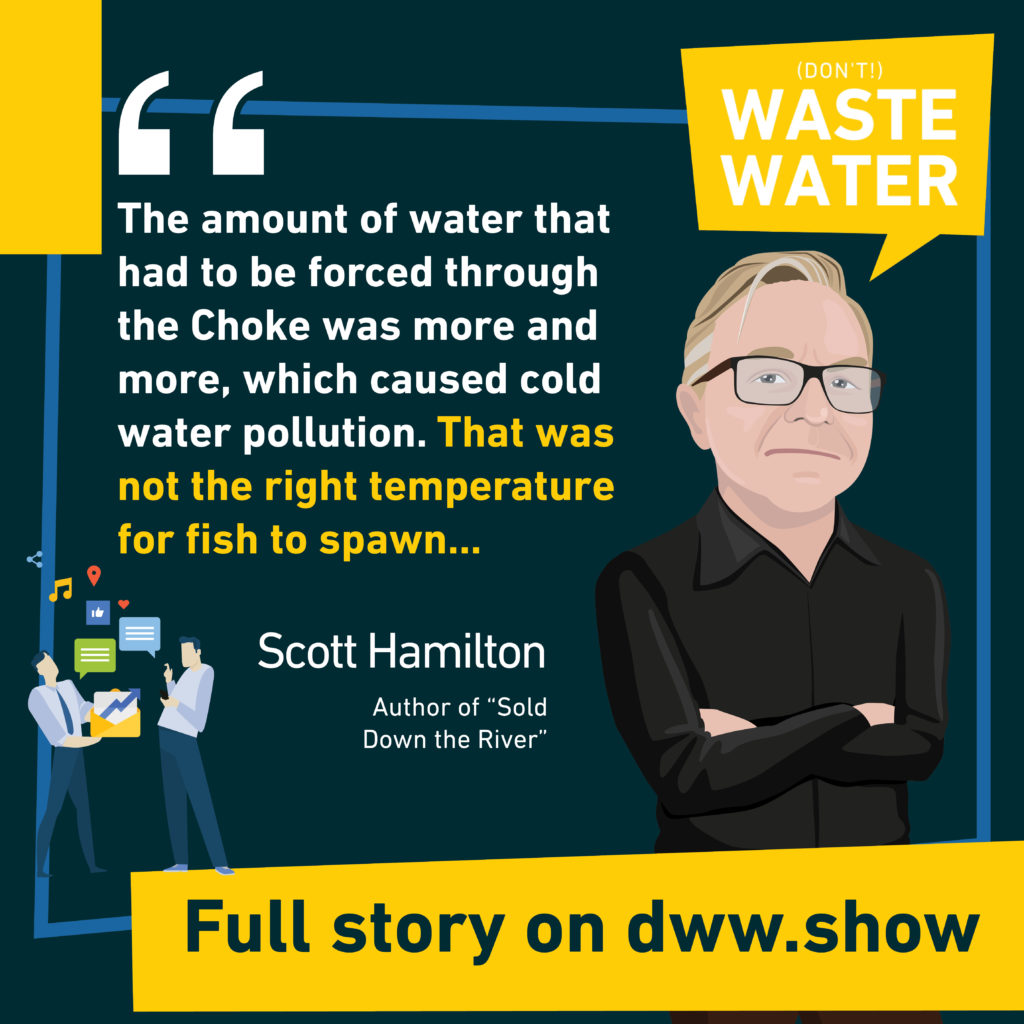
Scott Hamilton: unfortunately.
Yes. And let’s, you’ve got to get your head around that. That’s yeah. That’s. The girl, all the normal sort of things that we would see in, in getting back to this point about being all the normal rules and regulations about exerting market power and transparency and front running and nondisclosure, or what is normal rules don’t exist in this market, which is a fundamental problem.
So, yeah, and that’s, that’s got to change. And one of the other things that, um, is the issue with sort of the way that we’ve looked at this issue in the past, through the productivity commission or. Consumer commission or the comp competition, which is I don’t have the right tools to be able to follow the money and actually do the sort of forensic inquiry and that you need to do if people are really trying to, um, hide things in terms of the financial assets, especially when there’s big money involved as well.
So that’s a whole different skill set. It’s a whole different set of regulations. It’s a whole different set of powers, um, that are needed. And, um, so that’s why when, uh, America looks to us in terms of where it might go and it’s watermark that we say, don’t follow us.
Antoine Walter: Well, there’s so much more topics in a book that I could spend another two hours just questioning you about the book.
But I think that’s a first bone to remind everyone that they have to read your book. So the book is called salt on the river by Scott Hamilton, our guests, and guide into all of that today. And stewards kills you. So I’d put, of course, all the links to the book in the show notes, and now to close the deep dive, I have a crystal ball and you can have a look in my crystal ball and know your book is out and you start talking about it.
And hopefully the awareness is going to rise a beat around that. What would you see happening in five years?
Scott Hamilton: Even five years, we will see another massive drought because climate change will continue to buy. Sarah. It’s not a priests site that I’m seeing. Um, my hope is that there’s been the sorts of movement at the grassroots or the, um, the community level, like we’ve seen in climate.
And I suppose, as we’ve seen in some sort of the climate strike movement and those things, that’s the sort of things. I, I see that. And that’s what I hope to see in this sort of period in this crystal ball that you’re talking about. And I do think that people and the world is becoming more conscious of what is going on in the importance of our environment and ecosystem and natural resources.
So we are at a crossroads and, um, I’m hoping that we do say that sort of shifts and are more actually uplifted whilst I’m, I’m disappointed with Australia in terms of our work in the climate debates, going into Glasgow. Um, this year, our M really heartened by president Biden and the other world leaders in terms of the seriousness that they’re taking climate change, um, and the sorts of shifts we’re seeing now.
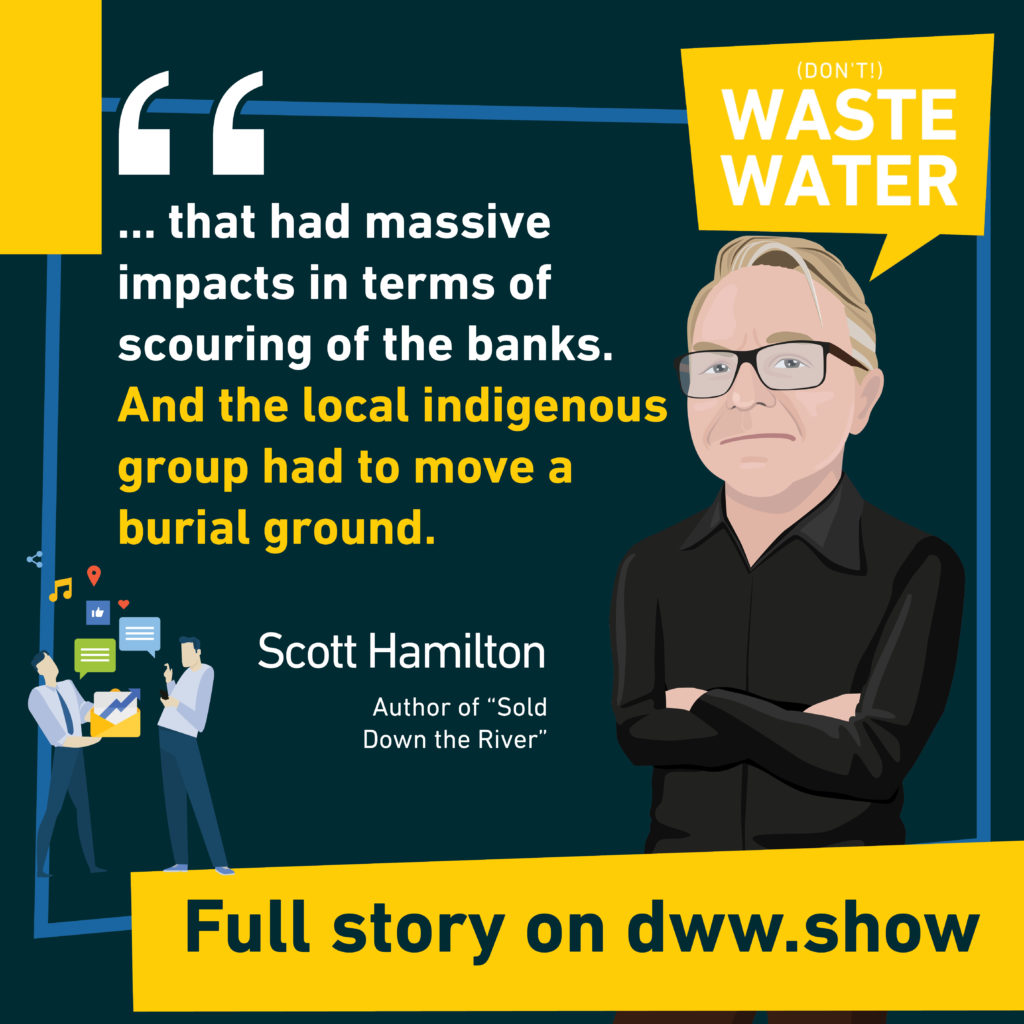
So, um, that does give me hope, which is what I’ll look forward to seeing in that crystal ball.
Antoine Walter: Well, I think that’s kind of the perfect conclusion to have hope on the end of the discussion, which can be somehow is hurting. So it’s really good to see that okay. Things happen, but they can be corrected. So what I propose to you is to switch to her last section for today, which is going to be the rapid for our questions
Rapid fire questions:
Antoine Walter: In that last section, I will ask you short questions, which M for short answers, of course I’m not cutting the microphone. If you need more time to explain, but you get the spirit. My first question is what is the most exciting project you’ve been working on and
Scott Hamilton: why? Sure, sorry.
One of the projects I’m currently working on is a certification scheme for green hydrogen, which is really making harsh and additive water using electrolysis, using lots of wind and solar power, which is a really big part of our solving the climate crisis.
Antoine Walter: Okay. So let me put a mental note here because I’m right now looking into making a deep dive into green and truck was hydrogen.
And there are several examples in Australia, especially around this truck was hydrogen. So that’s another discussion we have to have in the. There’s
Scott Hamilton: a global summit on this smoke on the 20th and 21st by the smart energy council that you might want to look at, it is fringe direct register. It’s got world leaders from all around the world.
I’m looking at the climate crisis and it’d be worthwhile having a look at your market and including me, I’ll, I’ll be on talking as well.
Antoine Walter: Can you name one thing that you’ve learned the hard way
Scott Hamilton: I’m thinking it’s that? Um, no matter how passionate you are and you’re hard, you work, um, the real, uh, you can’t change the world by yourself. And really the key is to how you get many people to work in a common direction and get, make, get the best out of other people, rather than just working harder and harder yourself.
Antoine Walter: Is there something you are doing today, new job that you will not be doing in 10 years?
Scott Hamilton: I hope not as many zoom calls,
personal
Antoine Walter: couples. Hopefully I get you. If we can have this follow on discussion around hydrogen face-to-face in Melbourne, I’m all in.
Scott Hamilton: Oh, that’s fair. I was afraid to be good too. I’d be happy to come and see you.
Antoine Walter: Sure. It’s a nice place as well. What is the trend to watch out for in the water sector?
Scott Hamilton: I think it is this, um, ability to make, um, large amounts of drink of water from desalination using very low cost, solar power and wind power.
That’s where I think we’re going to see some big shifts in the next five to 10 years.
Antoine Walter: If you were a world political leader, what would be your first action to influence the fate of the words? Water challenge.
Scott Hamilton: Yeah, look, I think that, um, oral world leaders should commit to a certain number of liters of water use per day.
So in, uh, in our part of the world, we had a target of 155 liters per person per day. Um, in America, they’ve got another target, but I think we should say they will have to live on a hundred liters per day for a year. I love that one. I can appreciate the water.
Antoine Walter: I’ve been discussing regularly with Paula Callahan from BlueTech research around an initiative, which is in the Netherlands, I think, which is called the 50 liters projects.
And they are showing that it’s just a matter of technology and how you put that around you. And if you’ll reuse that water, you never feel any scar city despite being on 50 liters, which is the absolute minimum, the world health organization sets as something inhuman would need to live with another fascinating topic.
Very well. And last question for today. Would you have someone to recommend me that I should definitely invite on that same microphone and as soon as possible? Yes,
Scott Hamilton: I do. Look, I would, um, invite Michael Mann. Who’s a climate scientist in the U S these just released a book called the new climate war. And I know that you’d like books.
I think that you’ll enjoy, um, then be good to, um, speak to Michael, I think,
Antoine Walter: well, thanks for the double recommendation for a cool guest and the cool book, which you’re right. I think it’s a good way to convey your message. And really, again, that’s going to be my closing advice to everyone listening to that.
There’s a good reason why I was so pumped up for the discussion today. It’s that I really enjoyed your book. And I think I read it in one pass, which is not that often because you know, I have two young daughters, so usually I get interrupted, but I managed to read it in one pass. It was pleasant, eye opening by men.
Yeah. And I learned so much. So thanks for the book and thanks for the discussion.
Scott Hamilton: Thank you so much for reaching out. And then you leveled to talk to you and friends can keep in touch.
Antoine Walter: Well, thanks to and we might have that sequel discussion on hydrogen.

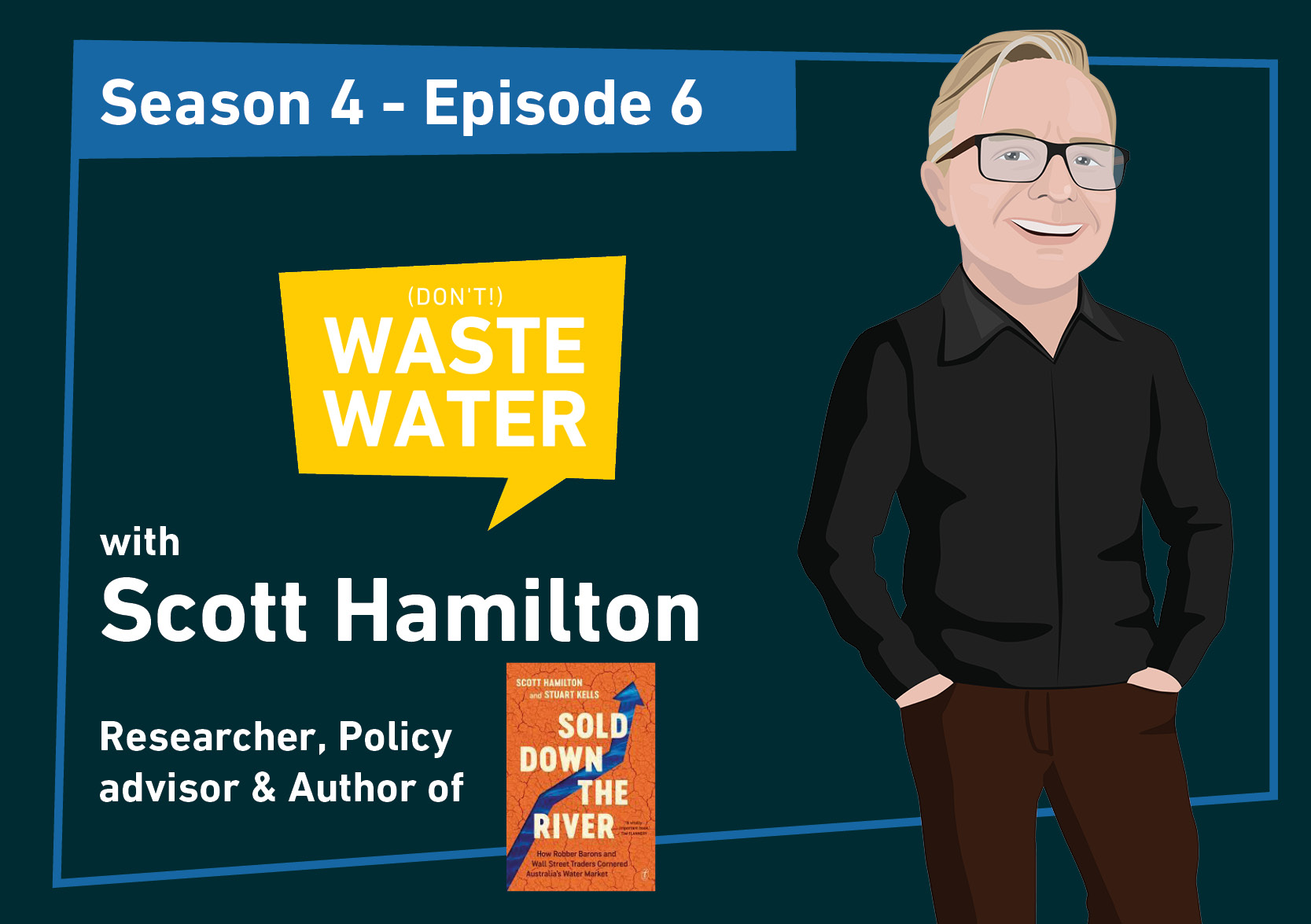




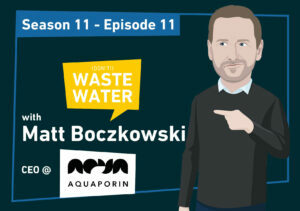
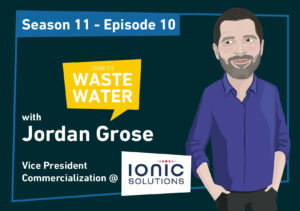


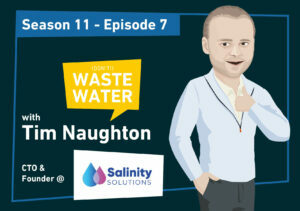


4 thoughts on “How Water Trading Unbelievably Killed One Million Fishes (and a River)”